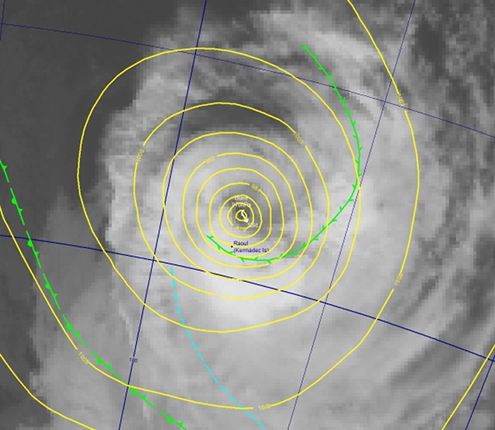John was one of a generation that became involved with weather forecasting during the Second World War. After leaving Auckland University College in 1937 he went teaching, and then was commissioned in the Meteorological Branch of the Royal New Zealand Air Force in 1942. He served in the Pacific Islands, where forecasters often flew with aircrews as observer/gunners, and occasionally took part in combat.
Albany Tornado, Tuesday 3 May 2011
Few weather events are as dramatic, dangerous or challenging to predict as tornadoes.
About the tornado of Tuesday 3 May 2011
On the afternoon of Tuesday 3 May 2011, a line of showers moved southwards across Northland. Ahead of this line the winds were moderate northeasterlies; behind it, they were moderate northwesterlies. Along the line, the winds converged - that is, pushed against each other. Below is a portion of a working chart for 3:00pm Tuesday 3 May 2011, drawn by one of the Severe Weather Forecasters.
MetService’s Investment in Forecasting
The practice of weather forecasting in a professional environment is subject to continual change, driven by advances in the science of meteorology and computing technology, as well as the changing needs of the end users – the people, businesses and public-sector agencies that make decisions based on weather information.
Funded through commercial activities
Tropical Cyclone Bune
World Met Day 2011
23rd March is World Meteorological Day.
Each year meteorologists around the world celebrate a chosen theme together to commemorate the anniversary of the founding of the World Meteorological Organization (WMO) on this day in 1950.
Storm Surge
Storm tide is the storm surge + the tide. King Tides occur soon after moon reaches its perigee within a day of a full or new moon phase.
FitzRoy: Inventor of the weather forecast
This article was originally written by Erick Brenstrum and published in New Zealand Geographic, issue 99 September-October 2009
Pirate Weather: Sir William Dampier, pioneer meteorologist
This article was written by Erick Brenstrum and originally published in New Zealand Geographic, issue 76, November-December 2005.
Tropical cyclones: extra-tropical transition
Written by Steve Ready Meteorologist
On average, about nine tropical cyclones form in the South Pacific tropics between November and April each year. Three or four of these leave the tropics and nearly all of them undergo a marked transformation to a mid-latitude cyclone – a completely different weather system – before they reach New Zealand.
Myth-busting Windburn
Written by Wayde Beckman from the Health Sponsorship Council.
February 2011
“I got windburnt today.” “My lips feel windburnt.” It’s something we hear from time to time (and even say ourselves) to explain red, sore, dry skin or lips after being outside. And in this glorious country of ours, it’s hard to be outside and not feel the sweet caress (or fierce pummeling) of the wind. But what is windburn? And can the wind really burn our skin?
